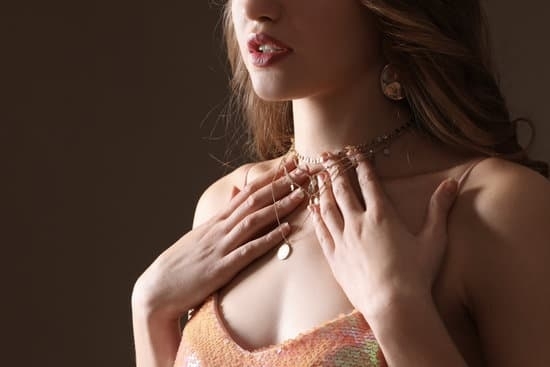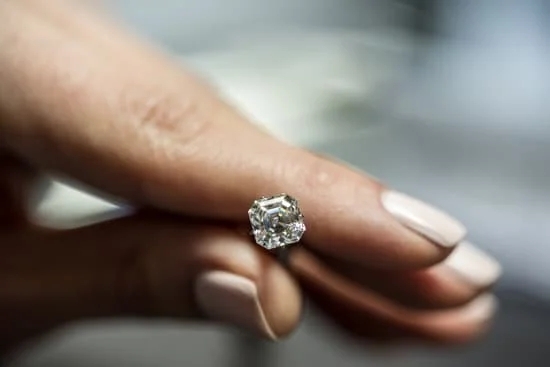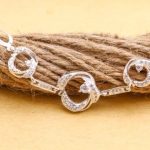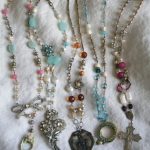Retro jewelry history is a fascinating subject, with many people enjoying perusing antique stores and flea markets in search of beautiful vintage pieces. From the elegant Accessories of Hollywood starlets back in the 1940s to the bold designs of the 1970s, each period in time has its own charm. Knowing that these timeless artifacts have endured for decades brings with it an added sense of wonder.
Prior to World War II, jewelry was typically crafted in platinum or gold and set with diamonds or other precious stones. Large statement pieces such as tassel necklaces and ornate brooches were considered de rigueur amongst the stylishly dressed women of the era.
During this time period, style icons like Ginger Rogers and Marlene Dietrich helped shape fashion trends by flaunting their dazzling jewelry collections on screens around America. As glamour and sophistication was essential during the 1940s, it was no surprise that people sought to emulate this era’s iconic designs when creating their own statement accessories.
The 1950s brought forth an alternative to this grand showy style when designers started making variations on key popular items like rhinestone earrings and pearl drop necklaces. Retro costume jewelry still remains very popular today, most notably as seen on stars like Sandra Bullock and Scarlett Johansson who spruce up their outfits with decades-old styles that take us all back a few years.
Famous designers including Kenneth Jay Lane have employed obsolete techniques such as the layering of different metals to create beautiful art deco-inspired pieces that never go out of fashion. Iconic designer Coco Chanel also made her mark during this decade after reinventing pearls from being seen as dowdy to edgy couture statuses symbolizing power and femininity while exuding timeless elegance.
In conclusion, retro jewelry design encapsulates many historical influences situated within various social settings during optimistic times where individuals expressed themselves in creative ways through unique designs. This rich cultural history is what makes vintage pieces so appealing – they’re more than just a collection of pretty baubles; they truly tell a story about popular culture from days gone by which will continue captivating our imaginations for decades to come.
Definition of Retro Jewelry
Retro jewelry refers to jewelry designs from the past, typically inspired by specific eras throughout fashion history. It is commonly associated with classic Hollywood stars like Ava Gardner and Audrey Hepburn, who presented iconic looks featuring these time-honored pieces. Retro jewelry is also often characterized as being bold, fun and creative. Examples of retro jewelry include multi-strand statement necklaces, drop or dangle earrings and layered bracelets – all pieces that celebrate a blast from the past.
Popular styles of retro jewelry range from art deco to bohemian chic. Art deco pieces typically evoke an elegant style of the 1920s with sharp geometric designs and highly stylized shapes expertly crafted into interesting patterns. These designs feature eye-catching metals such as gold and silver set with precious gems like diamonds and sapphires in asymmetrical patterns for a look that stands out on its own.
Meanwhile, bohemian chic celebrates the hippie era of the 60s, combining earthy elements such as shells, stones, beads and feathers for a vintage yet modern aesthetic. These extravagant pieces are often big stunners featuring unique accents such as dangling tassels in dramatic hues that add individuality to any outfit.
Finally vintage inspired cut-out rings made popular during the mid-century period are today’s “of the moment” trend in retro style accessories. These intricate geometric patterns designed via laser cutting technology offers a futuristic yet stylish look that can be elegantly matched with other fine jewelry for maximum impact in your wardrobe.
Crafted from metals such as rose gold or sterling silver accented with diamonds or colored stones, these mesmerizing designs will transport you back in time while adding just the right touch of sparkle to any ensemble.
History of Retro Jewelry
Retro jewelry has a long and fascinating history. Dating back as far as the 18th century, retro jewelry was made from many different types of materials including semi-precious stones and metals. Over time, this style of jewelry evolved slowly and steadily until it gained the iconic status it holds today.
The most popular era for the creation of retro jewelry is considered to be the early 1900s – much of which still survives today and is highly sought after. During this period, craftsmen used enameling techniques to create pieces with intricate details such as floral designs, geometric shapes, and even small animals or figures. Some more daring artisans of the time experimented with metalwork as well to develop some truly beautiful pieces that are now considered collector items.
Many of the modern adaptations of these vintage jewelry pieces focus heavily on nostalgia. Retro styled jewelry incorporates many design elements such as retro patterns, large stones in bold settings, layered chokers and cuffs created with wire mesh works or chains paired with an eclectic range of cabochons to provide elements for truly eye-catching creations once again adored by modern fashionista’s.
These designs along with variations have been produced all over the world making them accessible regardless of where you are based. Thus allowing everyone from any corner of the globe to experience that feeling when wearing a piece inspired by our past but also adapting styles for a modern twist for wearers today in time.
Design Influences
Retro jewelry is a timeless classic, having survived through changes in fashion and taste for more than a century. Though styles and fashions have come and gone, retro jewelry still stands out as attractive, eye-catching pieces of art. Understanding the historical context behind retro jewelry’s design helps us understand today’s contemporary jewelry pieces and allows us to appreciate their artistry even more.
The retro look is driven by the industrial revolution, with machine age metals popularizing such materials as aluminum, chrome, chromium plating and steel. Characteristic elements of the period include geometric shapes such as rectangles, circles and squares. Art Deco designs became very popular in this era, with diamonds, rubies, sapphires and emeralds used to create dazzling color combinations. Retro jewelry also featured elaborate settings that were often ornamental rather than functional.
In recent years there has been an upsurge of interest in vintage-style looks like those seen in the 1930s-1940s haute couture world. During this period many intricate designs took on a life of their own as prominent figures from all walks of life sought ornamental jewels crafted from precious metals such as gold, silver and platinum and set with precious stones ranging from diamonds to rubies to pearls.
Today’s contemporary jewelry designers continue to draw on these historic influences when crafting unique designs for modern customers seeking statement pieces featuring bold colors, geometric shapes and intricate settings inspired by jewellers of the past. By incorporating these classic themes into modern collections they are able to create stunning pieces with personality that appeal to any audience yearning for history-filled jewels that make a lasting impression.
Popular Motifs and Symbols
Retro jewelry is a unique style of jewelry that takes inspiration from the fashionable trends and designs from days past. This type of statement piece often includes elements from different eras, specifically from the 1930s through to the 1960s. During these time periods, many different motifs and symbols were used in gold and silver necklaces, pendants, brooches, earrings, chokers, and bracelets. Many of these pieces are still being collected for their beauty and uniqueness today.
The most popular motifs used in retro jewelry designs date back to Victorian times and contain symbols of love, romance, good luck, harmony and nature. Symbols such as hearts or stars represented love or passion while circles usually symbolized family unity or eternity.
Bows signified a bond of friendship while various animals represented courage or success. During Art Deco design styles (1920’s – 1940’s), geometric shapes with clean lines became popular and could be seen crafted from silver and platinum into geometric triangle pendants and charms with special meanings of strength and wealth attached to them.
In addition to representing special occasions or emotions, naturalistic motifs were also used in nostalgic jewelry pieces often seen on brooches and pendent necklaces which included depictions of flowers (like forget-me-nots), birds (like swallows) or angels often set in pearls or jewels.
Although highly decorated during this era not much information is available describing exactly what the individual motif meant at the time they were created though they remain popular pieces among collectors today because of their timelessness beauty.
The 1950’s saw an increase in popularity for bold colors such as coral pink blues greens multi color rings showcasing iridescent glass stones often arranged into flowers sunbursts butterfly shapes surrealist art works amongst other motif’s notable during this period. Retro vintage styles can still be found today if you look hard enough making it easy to connect with a little piece of history whenever you wear them.
Costume Jewelry and Imitation Pieces
The world of jewelry is filled with options that range from authentic pieces made of precious metals and gems to imitation and costume pieces. When it comes to authentic pieces, generally these are created with materials such as gold, silver, or platinum and adorned with diamonds, sapphires, rubies, and other gorgeous gemstones. The cost associated with these types of pieces can vary greatly based on the style, quality of craftsmanship, and elements used in creating the piece.
On the other hand is imitation jewelry. They may be made with base metals or other alloys such as bronze or stainless steel then plated in gold or silver for a shiny finish. Sometimes they may contain some CZs (cubic zirconia) providing a glimmer of extra dazzle throughout the piece. While many people choose this type of jewelry not only because it’s more budget-friendly but also because they often appear quite realistic – think “dress up jewelry”.
Costume jewelry can be thought of similarly to imitation jewelry in that it is often affordably priced and not created using precious metals and stone; however unlike imitation pieces there is no attempt made to replicate an authentic look. These are commonly flashy pieces featuring large vibrant stones crafted by artisans using colorful beads accompanied by plastic charms or baubles – think Hollywood glamour that won’t break your wallet.
While costume pieces do not hold any inherent value they can certainly be a fun way inject some personality into any ensemble while keeping your budget intact.
Rarity and Values
The value of vintage and antique jewelry pieces can be determined by several factors, such as rarity and age. The rarer the piece, the more valuable it typically is due to its limited availability on the market. The older a piece is, the more likely it is to be in pristine condition; therefore, vintage or antique pieces may fetch a higher price tag than those that are less than fifty years old.
Rarity and age also affect the desirability among collectors. Pieces that come from specific vintage periods such as Art Deco or Victorian timepieces are highly sought after because they represent an iconic era that has since passed.
Another factor that contributes to overall value is craftsmanship. Intricate details such as scrolled filigree designs, gemstone settings and engraved gold work are indicative of high quality craftsmanship from previous eras. High-end pieces created by well-known designers can go for significantly higher amounts due to their name recognition and status within the jewelry industry.
When evaluating a piece’s monetary worth, experts consider current demand for similar items on today’s market. If handmade stones like turquoise or quartz were used in your jewelry piece, then their scarcity will impact the overall value of your item if you plan to sell it one day. Condition should also be taken into account when maintaining its integrity over time as deterioration might cause a decrease in price.
Overall, rarity and age have a large bearing on how much people would pay for vintage and antique jewelry pieces both now and in the future. Paying attention to current trends and inspecting any necessary repairs are great ways of preserving the value of these timeless collectibles.
Conclusion
Retro jewelry is one of the most timeless and versatile types of jewelry. It has unique pieces that come from different eras that are always stylish and never truly go out of style. The history of retro jewelry spans back to the 1920s, when modernist design first gained momentum in Europe. During this era, new materials like enamel were experimented with and used to create bold and daring designs that broke away from traditional jewelry trends.
The 1950s marked an era of romanticism in retro jewelry history known as “Doo-wop Design” which focused on sculptural abstract shapes and amethyst or sapphire stones set in intricate gold settings. This led to Playful pin up pieces becoming popular with richly colored rhinestones, often shaped into bowties, floral arrangements, hummingbirds or insects.
There was also the classic charm bracelet made popular by Jackie Kennedy Onassis during this time which featured different charms designed by her for each occasion she attended.
Art Deco Jewelry became popular in the late 1920s all throughout the 1930s and 1940s as a sign of elegance and sophistication during these decades. This type of jewelry was typically made from geometric shapes made from white metals such as silver or platinum with diamonds added for sparkle. During this period, more rare materials such as jade began being used too in more creative designs that celebrated modernity much like cubist art at the time.
Today vintage jewelry still enthralls us with its beautiful designs that feature inspiration from many different decades making it a strong symbol of nostalgia while also staying current with fashion trends today.
These heirloom pieces can be seen adorning royalty and celebrities alike due to it’s everlasting appeal remaining timeless and versatile through all these years making them worth holding onto not just for sentimental value but because they remain relevant to this day being appreciated worldwide regardless of age or culture alike.

Welcome to my jewelry blog! My name is Sarah and I am the owner of this blog.
I love making jewelry and sharing my creations with others.
So whether you’re someone who loves wearing jewelry yourself or simply enjoys learning about it, be sure to check out my blog for insightful posts on everything related to this exciting topic!





